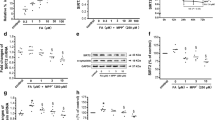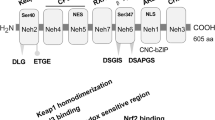Abstract
Parkinson's disease (PD) is characterized by oxidative stress and neuroinflammation as key pathological features. Emerging evidence suggests that nuclear factor erythroid 2 related factor 2-antioxidant response element (Nrf2-ARE), phosphatidylinositol 3‑kinase-protein kinase B (PI3K-Akt), c-Jun N-terminal kinase-extracellular signal-regulated kinase 1/2 (JNK-ERK1/2), and toll-like receptor 4/nuclear factor-kappa B (TLR4/NF-kB) pathways play pivotal roles in PD pathogenesis. Orientin, a phenolic phytoconstituent, has demonstrated modulatory potential on these pathways in various experimental conditions other than PD. In this study, we aimed to evaluate the neuroprotective effects of Orientin against rotenone-induced neurodegeneration in SH-SY5Y cell lines and the Swiss albino mice model of PD. Orientin was administered at doses 10 and 20 µM in cell lines and 10 and 20 mg/kg in mice, and its effects on rotenone-induced neurodegeneration were investigated. Oxidative stress markers including mitochondrial membrane potential (ΔΨm), reactive oxygen species (ROS), superoxide dismutase (SOD), catalase (CAT), and glutathione peroxidase (GPx), as well as inflammatory markers including interleukin-1β (IL-1β), interleukin-6 (IL-6) and tumor necrosis factor-α (TNF-α), were measured. The expression levels of genes related to Nrf2-ARE (Nrf2), PI3K/Akt (Akt), JNK-ERK1/2 (TNF-α), and TLR4/NF-kB (TNF-α) pathways were measured to understand the modulatory effect of Orientin on these pathways. Additionally, behavioral studies assessing locomotor activity, muscle coordination, and muscle rigidity were conducted with mice. Our results indicate that Orientin dose-dependently attenuated rotenone-induced changes in oxidative stress markers, inflammatory markers, gene expression levels, and behavioral parameters. Therefore, our study concludes that Orientin exhibits significant neuroprotective benefits against rotenone-induced PD by modulating Nrf2-ARE, PI3K-Akt, JNK-ERK1/2, and TLR4/NF-kB pathways.
Graphical Abstract







Similar content being viewed by others
Data Availability
The datasets generated during and/or analyzed during the current study will be provided on request.
Change history
16 April 2024
A Correction to this paper has been published: https://doi.org/10.1007/s11064-024-04138-4
References
Jenner P, Olanow CW (2006) The pathogenesis of cell death in Parkinson’s disease. Neurology 66:S24–S36. https://doi.org/10.1212/wnl.66.10_suppl_4.s24
Lang AE, Lozano AM (1998) Parkinson’s disease. Second of two parts. N Engl J Med 339:1130–1143. https://doi.org/10.1056/nejm199810153391607
Kuter K, Kratochwil M, Berghauzen-Maciejewska K, Głowacka U, Sugawa MD, Ossowska K, Dencher NA (2016) Adaptation within mitochondrial oxidative phosphorylation supercomplexes and membrane viscosity during degeneration of dopaminergic neurons in an animal model of early Parkinson’s disease. Biochim Biophys Acta 1862:741–753. https://doi.org/10.1016/j.bbadis.2016.01.022
Jenner P (2003) Oxidative stress in Parkinson’s disease. Ann Neurol 53:S26–S38. https://doi.org/10.1002/ana.10483
Abou-Sleiman PM, Muqit MM, Wood NW (2006) Expanding insights of mitochondrial dysfunction in Parkinson’s disease. Nat Rev Neurosci 7:207–219. https://doi.org/10.1038/nrn1868
Tansey MG, McCoy MK, Frank-Cannon TC (2007) Neuroinflammatory mechanisms in Parkinson’s disease: potential environmental triggers, pathways, and targets for early therapeutic intervention. Exp Neurol 208:1–25. https://doi.org/10.1016/j.expneurol.2007.07.004
Rascol O, Payoux P, Ory F, Ferreira JJ, Brefel-Courbon C, Montastruc JL (2003) Limitations of current Parkinson’s disease therapy. Ann Neurol 53:S3–S15. https://doi.org/10.1002/ana.10513
Lam KY, Ling APK, Koh RY, Wong YP, Say YH (2016) A review on medicinal properties of Orientin. Adv Pharmacol Pharm Sci. https://doi.org/10.1155/2016/4104595
Mendonça ED, da Silva J, dos Santos MS, Carvalho P, Papke DKM, Ortmann CF, Picada JN, Reginatto FH, de Barros Falcão Ferraz A (2016) Genotoxic, mutagenic and antigenotoxic effects of Cecropia pachystachya Trécul aqueous extract using in vivo and in vitro assays. J Ethnopharmacol 193:214–220. https://doi.org/10.1016/j.jep.2016.07.046
Sa**i DV, Krishnamurthy PT, Kandiyil AC (2022) Neuroprotective activities of Orientin: a review. Curr Tradit Med 8:20–30. https://doi.org/10.2174/2215083807666210913104505
Law BNT, Ling APK, Koh RY, Chye SM, Wong YP (2014) Neuroprotective effects of Orientin on hydrogen peroxide-induced apoptosis in SH-SY5Y cells. Mol Med Rep 9:947–954. https://doi.org/10.3892/mmr.2013.1878
Lu N, Sun Y, Zheng X (2011) Orientin-induced cardioprotection against reperfusion is associated with attenuation of mitochondrial permeability transition. Planta Med 77:984–991. https://doi.org/10.1055/s-0030-1250718
Tian T, Zeng J, Zhao G, Zhao W, Gao S, Liu L (2018) Neuroprotective effects of Orientin on oxygen-glucose deprivation/reperfusion-induced cell injury in primary culture of rat cortical neurons. Exp Biol Med 243:78–86. https://doi.org/10.1177/1535370217737983
Yu L, Wang S, Chen X, Yang H, Li X, Xu Y, Zhu X (2015) Orientin alleviates cognitive deficits and oxidative stress in Aβ1–42-induced mouse model of Alzheimer’s disease. Life Sci 121:104–109. https://doi.org/10.1016/j.lfs.2014.11.021
Guo D, Hu X, Zhang H, Lu C, Cui G, Luo X (2018) Orientin and neuropathic pain in rats with spinal nerve ligation. Int Immunopharmacol 58:72–79. https://doi.org/10.1016/j.intimp.2018.03.013
Wang X, An F, Wang S, An Z, Wang S (2017) Orientin attenuates cerebral ischemia/reperfusion injury in rat model through the AQP-4 and TLR4/NF-κB/TNF-α signaling pathway. J Stroke Cerebrovasc Dis 26:2199–2214. https://doi.org/10.1016/j.jstrokecerebrovasdis.2017.05.002
Wang S, Yu Y, Feng Y, Zou F, Zhang X, Huang J, Zhang Y, Zheng X, Huang X-F, Zhu Y (2016) Protective effect of the Orientin on noise-induced cognitive impairments in mice. Behav Brain Res 296:290–300. https://doi.org/10.1016/j.bbr.2015.09.024
Mosmann T (1983) Rapid colorimetric assay for cellular growth and survival: application to proliferation and cytotoxicity assays. J Immunol Methods 65:55–63. https://doi.org/10.1016/0022-1759(83)90303-4
Jaisin Y, Thampithak A, Meesarapee B, Ratanachamnong P, Suksamrarn A, Phivthong-Ngam L, Phumala-Morales N, Chongthammakun S, Govitrapong P, Sanvarinda Y (2011) Curcumin I protects the dopaminergic cell line SH-SY5Y from 6-hydroxydopamine-induced neurotoxicity through attenuation of p53-mediated apoptosis. Neurosci Lett 489:192–196. https://doi.org/10.1016/j.neulet.2010.12.014
Conlon PJ, Grabstein KH, Alpert A, Prickett KS, Hopp TP, Gillis S (1987) Localization of human mononuclear cell interleukin 1. J Immunol 139:98–102
Gerard GF, Fox DK, Nathan M, D’alessio JM (1997) Reverse transcriptase. Mol Biotechnol 8:61. https://doi.org/10.1007/BF02762340
Zhong Y, Zheng Q-y, Sun C-y, Zhang Z, Han K, Jia N (2019) Orientin improves cognition by enhancing autophagosome clearance in an Alzheimer’s mouse Model. J Mol Neurosci 69:246–253. https://doi.org/10.1007/s12031-019-01353-5
**ao Q, Cui Y, Zhao Y, Liu L, Wang H, Yang L (2021) Orientin relieves lipopolysaccharide-induced acute lung injury in mice: the involvement of its anti-inflammatory and anti-oxidant properties. Int Immunopharmacol 90:107189. https://doi.org/10.1016/j.intimp.2020.107189
Li D, Wang Q, Yuan Z, Zhang L, Xu L, Cui Y, Duan K (2008) Pharmacokinetics and tissue distribution study of Orientin in rat by liquid chromatography. J Pharm Biomed Anal 47:429–434. https://doi.org/10.1016/j.jpba.2008.01.035
Bishnoi M, Chopra K, Kulkarni SK (2006) Involvement of adenosinergic receptor system in an animal model of tardive dyskinesia and associated behavioural, biochemical and neurochemical changes. Eur J Pharmacol 552:55–66. https://doi.org/10.1016/j.ejphar.2006.09.010
Dunham N (1957) A note on a simple apparatus for detecting neurological deficit in rats and mice. J Am Pharm Assoc 46:208–209. https://doi.org/10.1002/jps.3030460322
Costall B, Naylor R (1974) On catalepsy and catatonia and the predictability of the catalepsy test for neuroleptic activity. Psychopharmacologia 34:233–241. https://doi.org/10.1007/bf00421964
Panov A, Dikalov S, Shalbuyeva N, Taylor G, Sherer T, Greenamyre JT (2005) Rotenone model of Parkinson disease: multiple brain mitochondria dysfunctions after short term systemic rotenone intoxication. J Biol Chem 280:42026–42035. https://doi.org/10.1074/jbc.m508628200
Sun W, Li H, Shen Y, **ao H (2021) Resveratrol attenuates rotenone-induced inflammation and oxidative stress via STAT1 and Nrf2/Keap1/SLC7A11 pathway in a microglia cell line. Pathol Res Pract 225:153576. https://doi.org/10.1016/j.prp.2021.153576
Kempuraj D, Thangavel R, Selvakumar GP, Zaheer S, Ahmed ME, Raikwar SP, Zahoor H, Saeed D, Natteru PA, Iyer S (2017) Brain and peripheral atypical inflammatory mediators potentiate neuroinflammation and neurodegeneration. Front Cell Neurosci 11:216. https://doi.org/10.3389/fncel.2017.00216
Lin C-C, Lin W-N, Cho R-L, Wang C-y, Hsiao L-D, Yang C-M (2016) TNF-α-induced cPLA2 expression via NADPH oxidase/reactive oxygen species-dependent NF-κB cascade on human pulmonary alveolar epithelial cells. Front Pharmacol 7:447. https://doi.org/10.3389/fphar.2016.00447
Chakkittukandiyil A, Sa**i DV, Karuppaiah A, Selvaraj D (2022) The principal molecular mechanisms behind the activation of Keap1/Nrf2/ARE pathway leading to neuroprotective action in Parkinson’s disease. Neurochem Int 156:105325. https://doi.org/10.1016/j.neuint.2022.105325
Golpich M, Amini E, Hemmati F, Ibrahim NM, Rahmani B, Mohamed Z, Raymond AA, Dargahi L, Ghasemi R, Ahmadiani A (2015) Glycogen synthase kinase-3 beta (GSK-3β) signaling: implications for Parkinson’s disease. Pharmacol Res 97:16–26. https://doi.org/10.1016/j.phrs.2015.03.010
Xu B, Bai L, Chen L, Tong R, Feng Y, Shi J (2022) Terpenoid natural products exert neuroprotection via the PI3K/Akt pathway. Front Pharmacol. https://doi.org/10.3389/fphar.2022.1036506
Mohamed YT, Salama A, Rabie MA, Abd El Fattah MA (2023) Neuroprotective effect of secukinumab against rotenone induced Parkinson’s disease in rat model: involvement of IL-17, HMGB-1/TLR4 axis and BDNF/TrKB cascade. Int Immunopharmacol 114:109571. https://doi.org/10.1016/j.intimp.2022.109571
Subedi L, Lee SE, Madiha S, Gaire BP, ** M, Yumnam S, Kim SY (2020) Phytochemicals against TNF α-mediated neuroinflammatory diseases. Int J Mol Sci 21:764. https://doi.org/10.3390/ijms21030764
Liu T, Zhang L, Joo D, Sun S-C (2017) NF-κB signaling in inflammation. Signal Transduct Target Ther 2:17023. https://doi.org/10.1038/sigtrans.2017.23
Choi I, Zhang Y, Seegobin SP, Pruvost M, Wang Q, Purtell K, Zhang B, Yue Z (2020) Microglia clear neuron-released α-synuclein via selective autophagy and prevent neurodegeneration. Nat Commun 11:1386. https://doi.org/10.1038/s41467-020-15119-w
Acknowledgements
The authors would like to acknowledge the Indian Council of Medical Research (ICMR), New Delhi, India for providing financial support for the study and the Department of Science and Technology – Fund for Improvement of Science and Technology Infrastructure in Universities and Higher Educational Institutions (DST-FIST), New Delhi, India for their infrastructure support to our department.
Funding
This work was supported by the Indian Council of Medical Research (ICMR), New Delhi, India. Grant No: 3/1/2/138/Neuro/2020-NCD-I. Author Deepak Vasudevan Sa**i has received research support from ICMR.
Author information
Authors and Affiliations
Contributions
DVS conceptualized and designed the study. Material preparation, data collection, and analysis were performed by DVS and AC. The statistical analysis was performed by DVS and MRN. The work was supervised by PTK. The first draft of the manuscript was written by DVS and all authors commented on previous versions of the manuscript. All authors read and approved the final manuscript.
Corresponding author
Ethics declarations
Conflict of interest
The authors have no relevant financial or non-financial interests to disclose.
Ethical Approval
This study was performed as per the guidelines of the CCSEA, India and the study was approved by the IAEC at JSS College of Pharmacy, Ooty (Approval number JSSCP/OT/IAEC/40/2019-20).
Additional information
Publisher's Note
Springer Nature remains neutral with regard to jurisdictional claims in published maps and institutional affiliations.
The original online version of this article was revised: due to Figures 2-6 were interchanged in the original version.
Supplementary Information
Below is the link to the electronic supplementary material.
Rights and permissions
Springer Nature or its licensor (e.g. a society or other partner) holds exclusive rights to this article under a publishing agreement with the author(s) or other rightsholder(s); author self-archiving of the accepted manuscript version of this article is solely governed by the terms of such publishing agreement and applicable law.
About this article
Cite this article
Vasudevan Sa**i, D., Thaggikuppe Krishnamurthy, P., Chakkittukandiyil, A. et al. Orientin Modulates Nrf2-ARE, PI3K/Akt, JNK-ERK1/2, and TLR4/NF-kB Pathways to Produce Neuroprotective Benefits in Parkinson's Disease. Neurochem Res 49, 1577–1587 (2024). https://doi.org/10.1007/s11064-024-04099-8
Received:
Revised:
Accepted:
Published:
Issue Date:
DOI: https://doi.org/10.1007/s11064-024-04099-8




